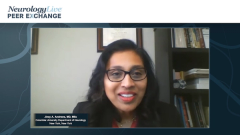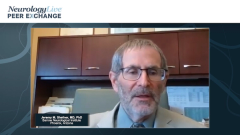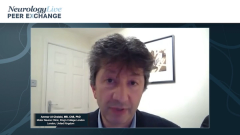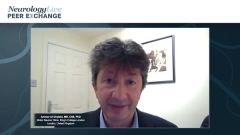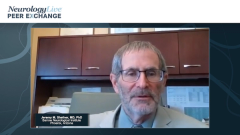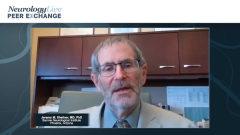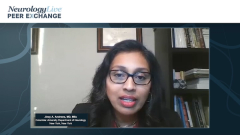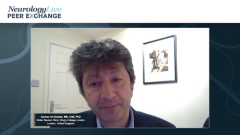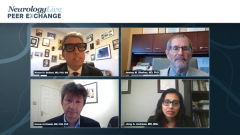
An Overview of Causes and Risk Factors for ALS
A panel of key opinion leaders in neurology provides an overview of the prevalence of amyotrophic lateral sclerosis (ALS) and discusses potential causes and risk factors.
Episodes in this series

Richard S. Bedlack, MD, PhD, MS: Hello, everybody, and welcome to this NeurologyLive® Peer Exchange, entitled “Progress in the Treatment of Amyotrophic Lateral Sclerosis [ALS].” I am Dr Richard Bedlack, director of the Duke ALS Clinic at Duke Health in Durham, North Carolina. I am pleased to be joined by some of my favorite colleagues in the ALS world: Professor Ammar Al-Chalabi, director of the Motor Neuron Clinic at King’s College London in the United Kingdom [UK]; Dr Jinsy Andrews, director of the Neuromuscular Clinical Trials Unit at the Columbia University Department of Neurology in New York, New York; and Dr Jeremy Shefner, senior vice president of Barrow Neurological Institute in Phoenix, Arizona.
Today we are going to discuss a number of topics pertaining to the diagnosis and current treatment of ALS in addition to therapies on the horizon. Let’s get started. First, I would like to do a bit of an overview here and talk specifically about the disease and how we diagnose it. Jinsy, what is ALS?
Jinsy A. Andrews, MD, MSc: ALS, amyotrophic lateral sclerosis, is a neurodegenerative condition, and it involves degeneration of the motor neurons, which eventually causes muscle weakness in voluntary muscles that we use for walking, climbing stairs, getting dressed, turning in bed, thinking, swallowing, and breathing. At present, there is no cure for the disease, and it is progressive in its nature.
As the disease progresses, it can present itself either as speaking difficulty, walking difficultly, or hand function difficulty, and it evolves over time. It is variable from person to person how much time that is, but it eventually involves all of the regions of the body until the disease affects the breathing muscles, and the patient is no longer able to breathe. It is considered a fatal neurodegenerative disease. That is essentially the big picture for ALS.
Richard S. Bedlack, MD, PhD, MS: I appreciate that. Who gets this?
Jinsy A. Andrews, MD, MSc: The scary part about this is that anyone is at risk of developing ALS: it is present in all ethnicities and racial backgrounds. It is a global disease.
Richard S. Bedlack, MD, PhD, MS: Is it common?
Jinsy A. Andrews, MD, MSc: It is not common when compared to diseases that everyone may be more familiar with, like cardiovascular disease and diabetes. But its incidence is about 1 to 2 per 100,000, and the prevalence is about 5 per 100,000. In America, there are about 30,000 people living with ALS. I do not know if any of our other colleagues want to comment on other regions.
Jeremy M. Shefner, MD, PhD: I would make a point that the incidence Jinsy mentioned seems low at 1 1/2 to 2 per 100,000 per year, but that is almost two-thirds of the incidence rate of a much more common neurological disease called multiple sclerosis [MS]. Almost the same amount of people get ALS and MS every year. The difference is that the life expectancy for MS is 40 to 45 years, and the life expectancy for ALS is 4 years or even less sometimes in some studies. The rarity of ALS has to do with the fact that it is rapidly fatal.
Ammar Al-Chalabi, MB, ChB, PhD: I would add that the lifetime risk of ALS is 1 in 300. Of course, the incidence of multiple sclerosis varies by latitude. In the UK, the incidence of multiple sclerosis and the incidence of ALS are the same. The lifetime risk of multiple sclerosis is also 1 in 300, but as Jeremy said, because the prognosis of ALS is so poor, the actual prevalence of it makes it seem low.
Richard S. Bedlack, MD, PhD, MS: Jinsy, are there any risk factors for getting this disease?
Jinsy A. Andrews, MD, MSc: For a few patients with ALS, there is a hereditary factor. Genetics play a role in a minority of cases: about 5% to 10%. For the individuals who have an associated gene mutation that we know causes ALS, the relatives of those individuals are also at risk of developing ALS. Other things like increasing age can increase your risk of developing ALS.
There are many reported associated risks with ALS; some that have been reported include things like smoking and environmental toxins. In the United States especially, there has been a strong emphasis on previous military exposure: serving 6 months of active duty or being a military veteran does put them at a higher risk than the general population for developing ALS later in life.
Richard S. Bedlack, MD, PhD, MS: Jeremy, what causes this disease to happen?
Jeremy M. Shefner, MD, PhD: This is a hard question to answer because we do not know. For about 1 in every 10 patients, there is clearly a family history. We have known this for probably 30 years. About 10% of patients with ALS have what we call familial disease. When we see this, the pattern of inheritance is usually autosomal dominant.
The first gene that was clearly shown to be responsible for some forms of inherited ALS was discovered in 1992: a gene for superoxide dismutase [SOD]. This gene codes for a protein that is incredibly common. The total amount of SOD1 protein in the body is about 1% of the total protein load: it is everywhere. How a point mutation in a gene that is as ubiquitous as that can cause a disease such as ALS is still one of the big challenges for us. Even more challenging is, when thinking about SOD1, there may be up to 100 different point mutations in this 1 gene, all of which cause one form of ALS or another.
You could damage this gene in one of myriad ways, and the same phenotype usually results. SOD1 only accounts for about 20% of familial ALS, and the largest contributor to inherited ALS is a gene that was discovered more recently called C9orf72. This is also primarily autosomal dominant. It is probably responsible for about 50% of inherited ALS, and it causes a variety of other thing besides ALS, including a specific form of dementia called frontotemporal dementia, as well as atypical Parkinson disease.
This is a gene that that can have a number of different expressions. Beyond these 2 genes, there are probably now about 50 other genes that have been identified in small family groups to clearly cause ALS in a small number of people. All these genes do a variety of things to the human nervous system. From the genetics, we have gotten some hints of what might be going on in sporadic ALS as well.
A defect can occur in what we call protein misfolding. Proteins in ALS tend to lose their characteristic confirmation and become misfolded and aggregated. This probably serves as a nidus of damage. We know that the passage of RNA from the nucleus to the cytoplasm to encode proteins is damaged, at least in some inherited forms. We know that inflammation plays a role in ALS in various forms of inflammatory cells, specifically microglia and T-regulatory cells, may be dysfunctional or may promote damage in ALS.
The complement cascade may be involved as well. There are abnormalities that may lead to abnormal programmed cell death. There are a host of other hypotheses for or observations that lead us to different targets that may be relevant, but we do not have a single unifying concept to say what causes ALS.
Richard S. Bedlack, MD, PhD, MS: Thank you. It sounds like, even though there are 50 different genes, altogether they only account for about 10% of the causes of ALS. Ammar, you have any idea about what might be out there causing the other 90%? Jeremy mentioned some downstream processes that ultimately kill motor neurons, but those are not the cause of it. Are there things in the environment that are causing this in people?
Ammar Al-Chalabi, MB, ChB, PhD: The first thing to say is that we already know some of those same genes that cause familial ALS also apparently cause sporadic ALS. Between 15% and 20% of people with no obvious family history can be found to have a genetic variation in one of those genes, and in most but not all of those cases, there is strong evidence that that is probably contributing to the cause.
Finding environmental risk factors is much trickier because, although the genome is vast, it is a finite thing, and we know what we are testing. With the environment, it could be absolutely anything at any point in the person’s life or a combination of those things. It becomes extremely difficult to try to disentangle that. There are various techniques that can be used to try to attempt that. Jinsy has mentioned some of them, which are epidemiological studies, but those are dependent on the recall of the person who is being asked, and that is not good, particularly for distant things. For example, smoking. Something like 25 different studies have been done looking at smoking as a risk factor for ALS; about half of them say it is, and about half of them say it is not.
For example, we at Motor Neuron Clinic, King’s College London have done a large study called a Mendelian randomization study in which we looked to see if there is a causal relationship between smoking and ALS, and we found none at all. That tells you the difficulty in finding these environmental risk factors.
Jeremy M. Shefner, MD, PhD: To make a point on that, Jinsy mentioned that military service during times of conflict is fairly clearly a risk factor for ALS, in the United States at least. That is true for military veterans who served in World War I, World War II, the Korean War, the Vietnam War, and the first Gulf War. If you think about the environmental situation in those vastly different time frames, it is hard to find a unifying factor that fits into this. It may have to do with the physical stress of combat. It is hard to know, but it points out the difficulty of even finding an environmental causation and then making sense of it.
Ammar Al-Chalabi, MB, ChB, PhD: Another factor to consider is that, for something we think might be a risk factor, the way we interpret it can be biased. For example, exercise has been suggested as a risk factor for ALS because all neurologists will know that, anecdotally, we see people who are sporty in our clinics, far more than we would in a more general clinic. That suggests that exercise might predispose you to ALS, but firstly, association is not causation. It might be that, if you have a motor system programmed well so that you are good at sports naturally and therefore gravitate toward them, then you are prone to ALS regardless of whether you do the exercise. Or it may simply be that, if you do exercise, it makes no difference to your risk but actually slows the condition once you have it, in which case, people who are sporty will be more prevalent in our clinics because they’ll live long enough to reach them. It can be extremely difficult disentangling all of these different factors when you are trying to find environmental causes.
Richard S. Bedlack, MD, PhD, MS: Thank you for watching this NeurologyLive® Peer Exchange. If you enjoyed the content, please subscribe to our e-newsletters to receive upcoming Peer Exchanges and other great content right in your inbox.
Transcript Edited for Clarity
Newsletter
Keep your finger on the pulse of neurology—subscribe to NeurologyLive for expert interviews, new data, and breakthrough treatment updates.

